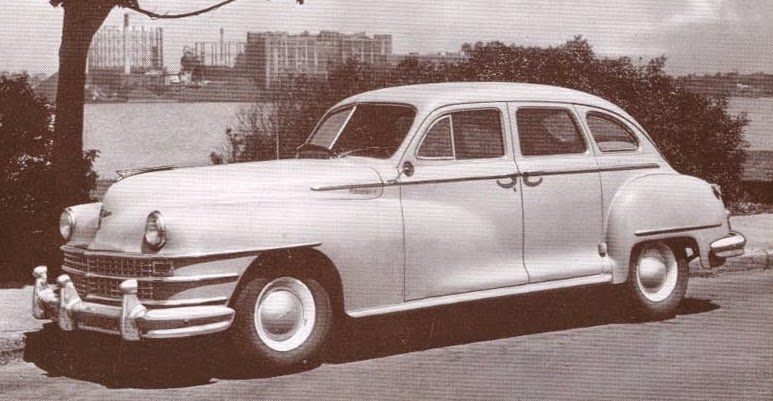It seems that the last prewar Chrysler brands shared the same set of bodies as an economy measure, and this carried over to the facelifted models and even to the redesigned 1949 line. Product managers and stylists therefore had to find ways of creating a marketable gamut of cars ranging from low-priced to near-luxury based on bodies that were essentially the same from the cowling to the rear end.
Here is what they did.
1946 Plymouth brochure page
Plymouth was Chrysler Corporation's entry-level brand and received the least-drastic facelift -- mainly a restyled grille. Note that the front fenders extend almost to the front door. Fun detail: the artist did not include the exterior hinge at the lower-right part of the rear door; that out-of-style hinge can be seen in some of he images below.
1947 Dodge advertisement
Dodge was the first step up from Plymouth in Chrysler's lineup. Dodges had longer hoods than Plymouths, and the front fenders faded over the front doors in line with current styling fashion.
1946 DeSoto
The next notch up the price-prestige rank from Dodge was DeSoto. It too had a long hood and fenders flowing onto the front doors. Both Dodge and DeSoto had bold grilles, yet their overall appearance was balanced.
1947 Chrysler (postcard image)
The same cannot be said for Chrysler, the corporation's top-of-the-line near-luxury brand. Flow-through fender extensions over the doors were like those on Dodges and DeSotos. The difference is the even-longer hood. That, coupled with an elaborate grille and two chrome strakes extending to the front wheel opening, created a nose-heavy, unbalanced appearance. After all, the body aft of the hood was essentially the same as Plymouth's.
1947 Chrysler Imperial Limousine
Balance was restored for Chrysler limousines. The passenger cabin was lengthened -- note the wider doors here compared to those on the Chrysler in the image immediately above.





No comments:
Post a Comment